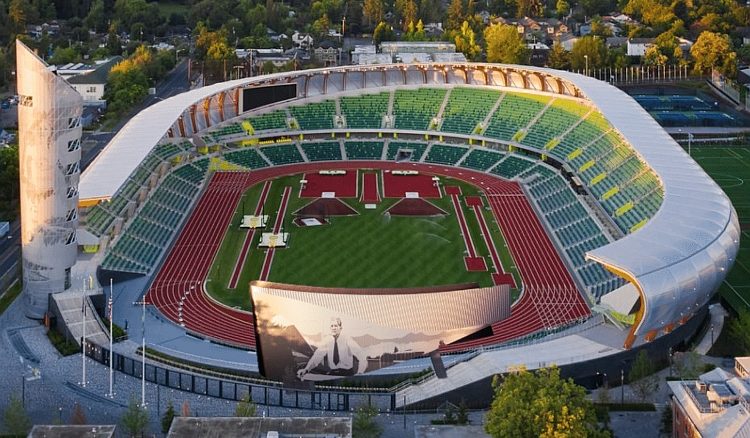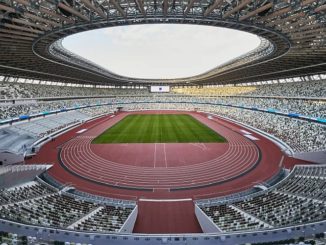
● From our sister site, TheSportsExaminer.com ●
The pre-opening publicity materials issued in March 2021 for the renovated Hayward Field at the University of Oregon stated that the track & field facility’s capacity would be “12,650 permanent seats expandable to nearly 25,000.”
It probably wasn’t true then, but it certainly isn’t true now. And that might be just as well.
The 2022 World Athletics Championships will be held at Hayward Field, as will be the Pac-12 Championships, Prefontaine Classic, NCAA Championships and USA Track & Field Championships. In today’s mostly-uninspired market for track & field – this week’s Penn Relays excepted – only the World Championships need any more seating than the facility’s permanent stands and promises of up to 30,000 seats were made at varying times.
But that was before the massive Visual Experience Board was installed this spring, spanning 160 feet in length by 60 feet high and incorporating 5,080 sq.ft. of video screen. There went several thousand of those extra seats.
So how many seats will there be for the Worlds? Glad you asked, because TheSportsExaminer made a count. Right from the Worlds ticket-sales screens.
Let’s start by accepting the 12,650 permanent seating total as accurate; the facility appears to be of about that size. The question is how much is being added on for the Worlds; by examining the ticket-sales site, we saw and counted:
● The standard seating configuration at the new Hayward has 60 sections, with 33 on the 100 level (lower tier) and 27 on the upper (200) tier.
● For the 2022 Worlds, lower-tier seating was added as sections 100-101-102-111-137, adding 749 seats.
● New upper-tier seating was added as sections 232-233-234-238-239-240-241 on either side of the new scoreboard, adding 2,130 seats. That’s 2,879 seats in new sections.
● Existing sections were built up along the north end, in front of the new scoreboard, in sections 129-136, adding 1,692 seats to the regular inventory.
● Add it up, and there are 4,571 new seats added for a total seating capacity of 17,221. By our count, that’s the expanded Hayward Field capacity for the 2022 Worlds.
At least 2,430 seats were lost to the new scoreboard and maybe more, that could have pushed the Worlds capacity to a believable 20,000. At an average of $75 each across 10 days, that’s at least $1.82 million in lost ticket sales, not to mention concessions and souvenirs. That hurts.
Let’s note that the 17,221 seating capacity is not how many tickets are available for each session. Before any ticket sales began, seven prime sections were marked as unavailable for public sale, nos. 117-118-119-120 and 218-219-220. These are on the finish line, moving into the first turn.
These will be used for news media (press, radio and television), officials, sponsors and athletes, all necessary for the event, but who are either not buying tickets at all (media, officials, athletes) or have already paid otherwise (sponsors). The tables for press and announce positions for television will remove an average of roughly two seats for every person who actually sits down, eliminating from 500-1,000 seats (or more) in the process.
Those seven sections represent – by our count – 2,704 seats, which brings the total for the public (including the high-priced hospitality seats) down to 14,517 available for sale.
How does this compare to the old Hayward? A lot smaller. The 2008 Trials averaged 20,890 attendees per day (167,123 total), the 2012 Trials drew 173,153 for eight days, an average of 21,644, and the 2016 Trials was the biggest of all.
That event had an average attendance of 22,122 over eight days of competition, with a high of 22,944 on the final day of 10 June, which was apparently a Hayward Field record. It likely will be forever.
Now, is the 2022 actual capacity of around 16,000 per session a humiliatingly small total for the first Worlds in the U.S., the most powerful track & field nation in the world?
If you look over the history of the IAAF Worlds, which began in 1983, yes. The first Worlds, in Helsinki (FIN), averaged 48,300 for the seven evening sessions. The 1987 follow-up in Rome averaged 64,750 each day. As late as 2017, the London Worlds averaged 53,404 for each of the 10 evening sessions. The smallest listed capacity was 42,000 for the 1995 Worlds in Goteborg (SWE).
But if you consider more recent events, no.
The 2019 Worlds in Doha was a new low, with a late date, hot weather and political turmoil among the Gulf states that isolated Qatar and eliminated any tourism. The Khalifa International Stadium was downsized to 21,000 – from its usual 48,000 – and drew 13,288 on the first night and it went down from there, but filled up for the last weekend thanks to the distribution of a lot of free tickets.
Now comes Eugene and the new Hayward Field, which will be full and very loud, with an intimate feeling and lots of excitement on the track. In many ways, having about 16,000 people there is about right.
There’s no parking anywhere close, even for buses. There’s not enough accommodations to take care of the people already coming, who will be spread about from Portland (110 miles to the north) to Roseburg, 71 miles to the south, and beyond. What would you expect from the no. 117 media market in the U.S.?
If there really were 30,000 seats at Hayward for the Worlds, how much worse would it be for those attending? A lot worse.
So this is where we are in track & field in the U.S. in 2022, and where World Athletics sits as well. But not for long. The 2023 Worlds will be held at the under-construction National Athletics Centre in Budapest, with a permanent capacity of 14,000, but planned to hold 36,000 for the Championships in one of the historic capitals of Europe. It can handle the guest load.
And there is Tokyo, with its beautiful new National Stadium, which sat empty for the Olympic Games last year, but which is being offered for the 2025 Worlds and seats 68,000. World Athletics might go to Nairobi instead, which has the 60,000-seat Kasarani Stadium available.
By then, Eugene will – hopefully – be a pleasant memory of great performances, lively crowds and not too much inconvenience for those spectators who are there. And American track fans will be looking forward to the third Olympic Games to be held in the Los Angeles Memorial Coliseum in 2028.
Bobby McFerrin was right. Don’t Worry, Be Happy.
~ Rich Perelman




Be the first to comment